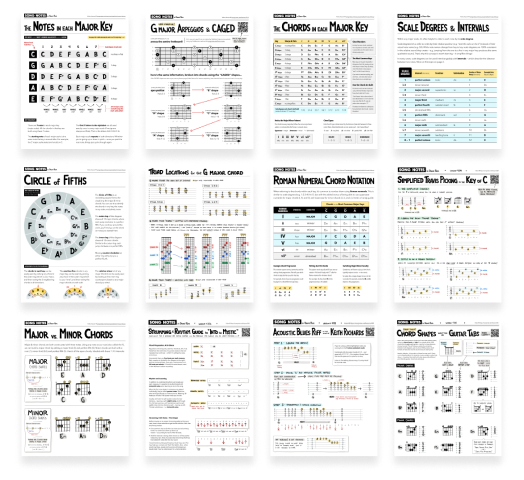3 string triad magic, in the style of Dire Straits
Lesson #174 • Sep 18, 2018
Description
As I took the first steps into learning “Sultans of Swing”, one of the things that jumped out immediately was this incredibly recognizable chorus lick - and how playing it by itself can be an entirely satisfying exercise. After spending some time with it, I decided to craft some constraints around it: specifically, introducing the challenge of only using 3 strings to play all of the necessary chords.
While this may seem like a challenging constraint, it actually makes the lick a bit more accessible, in my opinion - it allows you to avoid any “full” barre chords that require 5 or 6 strings. As such, I present to you this quick warm-up exercise based on this riff. It’s a great one to memorize to turn heads wherever you may find yourself with a guitar, and likewise will help you develop barre chord muscles if you haven’t yet mastered the 5- or 6-string barre. Enjoy!
Free Lesson
Slow Playthrough
A zoomed-in, slow playthrough of this full exercise with tabs shown on the screen. Requires membership to Song Notes Premium.
Instructional PDF 2 pages
Lesson Discussion
Full chorus lick
See the Instructional PDF (above) for complete tabs, with timing included.
Understanding the full chord shapes
Although this riff requires you to only 3 strings per each chord, it’s worth understanding the “full” version of these very same chords. Doing so will help you develop “barre chord vision” (as I call it), wherein you’re able to recognize the full 5- or 6-string chord shapes from which you may play 2, 3, or 4 strings.
E ––––5––––3––––8––––1––––5––––8–––
B ––––6––––5––––8––––3––––6–––10–––
G ––––7––––5––––9––––3––––5–––10–––
D ––––7––––5––––10–––3––––7–––10–––
A ––––5––––3––––10–––1––––8––––8–––
E ––––––––––––––8––––––––––––––––––
Dm C C Bb F F
Playing the 3-string chord shapes
Given the full chord shapes above, here’s how I recommend playing the 3-string versions of each chord as follows. For the D-minor, ideally keep your left index finger free – this lets you (eventually) use it to barre the 5th fret, which is useful for both the 3-string C-major and the full 5-string D-minor.
E –––––––
B –––6––– <== left middle
G –––7––– <== left pinky
D –––7––– <== left ring
A –––––––
E –––––––
Dm
Here’s the C and Bb chords. For these, the ideal is to play all 3 strings with your barred index finger. This is a great way to develop barre chord strength (i.e., barring 3 strings is a great stepping stone toward being able to barre 5 or 6 strings).
E ––––––––––––
B –––5––––3––– <== left index
G –––5––––3––– <== left index
D –––5––––3––– <== left index
A ––––––––––––
E ––––––––––––
C Bb
For the F chord in the 2nd segment, use this tab. The idea is to barre your left index finger across the 5th fret, and then use your left middle and ring fingers for the other strings. This approach makes it very easy to quickly switch from the F to the C (since your index finger is already barred on the 5th fret).
E –––––––
B –––6––– <== left middle
G –––5––– <== left index
D –––7––– <== left ring
A –––––––
E –––––––
F
Finally, there’s the F and C chords further up the neck. For the F, the ideal is to use your left ring finger to barre the 10th fret – which lets you use that same ring finger on the 10th fret of the 4th string (for the C chord).
E –––––––– E ––––––––
B –––10––– <== left ring B ––––8––– <== left index
G –––10––– <== left ring G ––––9––– <== left middle
D –––10––– <== left ring D –––10––– <== left ring
A –––––––– A ––––––––
E –––––––– E ––––––––
F C
Other riffs that use these chords:
“All Along the Watchtower” by Bob Dylan uses the same tonal progression (though in a different key) - and can be played by repeating Dm - C - Bb - C:
E ––––––––––––––––––––––––
B ––––6––––5––––3––––5––––
G ––––7––––5––––3––––5––––
D ––––7––––5––––3––––5–––– ...repeat
A –––(5)––(3)––(1)––(3)–––
E ––––––––––––––––––––––––
Dm C Bb C
“The First Cut is the Deepest” by Cat Stevens can also be played with these shapes:
E –––––––––––––––––––––––––––––––––––––––––––––––––––
B ––––––––10––––––––––––8––––––––––6––––––––––8––––––
G –––––10––––10–––––––9–––9––––––7–––7––––––9–––9––––
D ––10–––––––––––––10––––––––––8–––––––––10–––––––––– ...repeat
A –––––––––––––––––––––––––––––––––––––––––––––––––––
E –––––––––––––––––––––––––––––––––––––––––––––––––––
F C Bb C
And those are just a few - play with these chord shapes yourself and see what other sequences you can come up with!
Enjoy my lessons? Buy me a beer!
If this and my other lessons have proven helpful to you, please consider making a one-time donation to my tip jar. Contributions of any amount help make this project possible (including the many, many hours I put into it).
Fun & Helpful Tools I've Made
Subscribe to my YouTube channel
Be sure to never miss a lesson by subscribing on YouTube. I put out 2-3 new videos every week. These include full song lessons, as well as covers, practice tips, behind-the-scenes updates. Thanks!
Recent Lessons
-
April 18, 2024
"Moonshadow" by Cat Stevens
-
April 9, 2024
Chords & Music Theory... 9 New Lessons!
-
March 30, 2024
Gordon Lightfoot's "Carefree Highway"
-
March 22, 2024
Lead Guitar & the F1 Theme Song
-
March 15, 2023
Pink Floyd's "Breathe" - with Simpler Chords Included
-
March 6, 2024
Q&A: 8 Tips to Avoid Muting Strings
-
March 1, 2024
Blues Shuffle Riffs - Using Just 2 Strings!
-
February 16, 2024
Soulful Lead Guitar with "America the Beautiful"
-
February 8, 2024
Country Honk by The Rolling Stones
-
January 31, 2024
Beginner Blues - New Course Sneak Peek!


